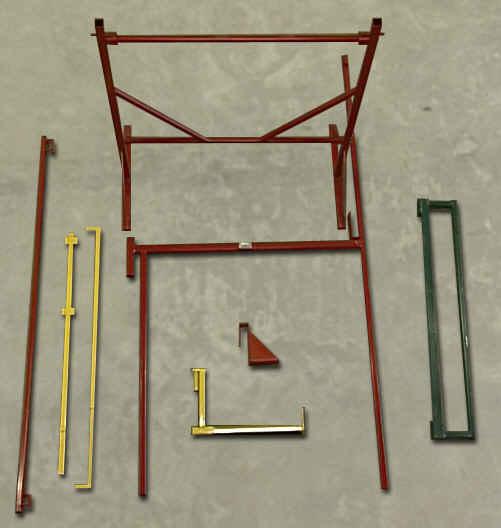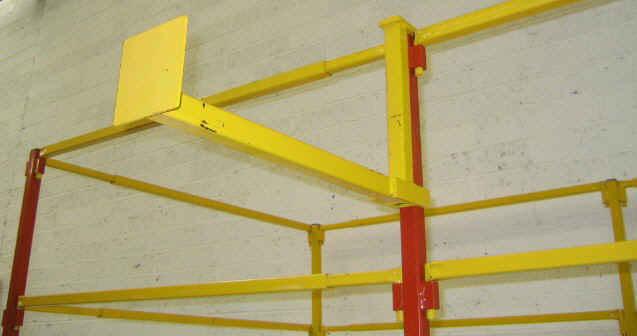Safestand Limited, a UK supplier of trestle systems allowing builders to work at an elevated height, was required to go to the Court of Appeal to overturn an adverse finding on validity caused by unclear representations in its registered designs. This decision confirms the importance of preparing accurate registered design images and ensuring careful thought goes into how to represent a product.
Background
Safestand had previously sought to enforce their patents and registered designs at the High Court against Weston Homes plc, Weston (Logistics) Limited and Weston Group Limited. At the High Court, although the patents were deemed to be valid and infringed by Weston, the judge considered that each of the registered designs was invalid for lacking clarity, and failing to conform to the definition of a “design” in the sense that this refers to a single product.
The UK registered designs are Nos. 90002293490001, 90003121450004 and 90003121450005, which relate to a scaffold. Some images are shown below.
0001



0004



0005



As can be seen from the above, the registered designs concerned are undoubtedly difficult to understand. Each contains a number of interconnectable components, which may be assembled in various ways, and which appear to be depicted in different colours.
Due to these inconsistencies, the judge considered that each of the designs sought to protect different versions of the scaffold, rather than a single product as required by the law. The designs were therefore deemed to be invalid for relating to more than one product, or for being so unclear that it could not be reasonably determined that they do, in fact, each relate to a single product.
Court of Appeal Decision
The dispute between the parties was settled before the case reached the Court of Appeal. However, because Safestand’s registered designs had been declared invalid by the lower court, in order to maintain its design registrations, Safestand was nevertheless forced to appeal the earlier decision in respect of validity. Whilst Safestand was ultimately successful, it had to go some way to convince the judges to overturn the earlier decision.
Reference to Commercial Product
In an interesting judgement, it was first held permissible for the Court to refer to Safestand's trestles when interpreting the registered designs, “at least for the purpose of confirming conclusions drawn from the images”. This was an important point given the difficulties the lower court had in interpreting the design representations. The ability to refer to the commercial product played squarely in Safestand's favour, by effectively “filling in the gaps” caused by the inconsistencies mentioned above.
Complex vs Modular Products
The Appeal then turned to the question of whether the design is that of a single product. The legislation makes clear that design protection may reside in a “complex product” that is composed of two or more replaceable component parts permitting disassembly and reassembly. The scope of such design protection can be easily understood when the two components are only connectable in a single configuration. However, this becomes more difficult when the components are numerous and connectable in a variety of different ways.
Safestand argued that it is clear from the design representations that they depict a modular design that enables scaffolding of different configurations to be assembled from the different components shown in the registered designs, and that this is confirmed by inspection of its commercial product. Safestand argued that this modular design constitutes a single product, albeit one with an inherent degree of variability. The judge agreed, and found that a modular product is “a type of complex product consisting of a series of standardised parts or units from which the complex product is assembled”. Since the product is modular, the judge accepted that, considered together, the views depict the design of a single product.
Inconsistencies
By virtue of the fact that the product is modular, the judge waived the apparent inconsistencies in the use of colour. The judge commented “I suspect that Safestand’s intention was that the colours would represent a code as to the different types of components included in the designs, but that mistakes were made in the colouring of some components”.
Optional Features
The judge, interestingly, added an important additional point on the topic of a single product by stating “…the design of a single product may include items whose use is optional”. In the present case, Safestand argued that features, such as a ladder bracket depicted as present or absent meant that such a feature was optional, even though it was not properly depicted as such (e.g. by using a visual disclaimer, such as for the ladder itself).
The presence of optional features was considered allowable due to the product being deemed modular and by inspection of the commercial product. The judge applied a very broad interpretation to the designs as a result, meaning that combinations of specific components and colours could be considered one of many optional configurations. Safestand was therefore able to both avoid a common pitfall of not properly disclaiming optional features, and to benefit from a broader scope of design.
Conclusion
This case highlights the importance of preparing registered designs with representations that are as clear and consistent as possible to mitigate the risk of the designs being misunderstood or considered invalid. In the present case, it seems that the Court of Appeal was prepared to be quite lenient in its interpretation of the representations, and in particular seemed prepared to read in additional information with the assistance of the commercial product. However, from an outside perspective, the judgment reads as a difficult series of registrations being saved by good argumentation and legal work. If just one of the inconsistencies had stuck, then it is possible that the designs may have been held invalid and been revoked.
In our view, this case serves as a reminder that when preparing design representations, careful consideration should be used as to the strategy for protecting the product, including whether to use colour or not and the form of representations. For this case, the use of colour is quite limiting on the scope of protection, and a set of designs in grayscale with consistent colouring would have been recommended. It would have been a good option also to have separate registered designs using line drawings, devoid of colour or shading, and/or CAD images in greyscale, to resolve some of the clarity problems with the lack of resolution in the photographs, to have a broader scope of protection, and to provide more options for enforcement.
In the present case, if colour was an important part of the design, it may have been better to ensure that each design used one colour scheme, to protect a smaller part of the modular system, with one or more additional registered design filings covering the complete set of possible modular components in all colours.
It may also have been better to include more than one assembled view, from a different perspective, to help resolve ambiguities in what was shown. Each registered design included more magnified views of parts of the product than assembled views, and perhaps it would have been better to cover the small components in another design application, rather than expending one design view on such small components of the system. Given that multiple designs are generally inexpensive when compared with patents, and additional designs would have allowed for better clarity in showing such a complex product, it may have been worth that additional cost of filing further designs at the outset.
It is also worth noting that a commercial product can change over time, and therefore this brings into question whether changes to the commercial product can have an effect on the interpretation of a registered design should this be used as a reference point as in the Safestand case. This is yet another reason for applicants to have a clear strategy and scope of protection when filing the registered designs.
At Marks & Clerk, our dedicated team of designs specialists has extensive experience preparing design applications across a wide variety of industries. If you or your company has a design matter with which you require assistance, please do not hesitate to get in touch.



/Passle/6130aaa9400fb30e400b709a/MediaLibrary/Images/2025-12-11-20-15-51-296-693b26774973e04fad1554d9.png)
/Passle/6130aaa9400fb30e400b709a/SearchServiceImages/2025-12-08-11-57-42-429-6936bd366a72147741b9b9e4.jpg)
/Passle/6130aaa9400fb30e400b709a/SearchServiceImages/2025-12-10-09-48-03-263-693941d324600bff03cbae5e.jpg)